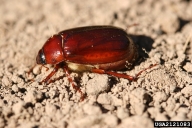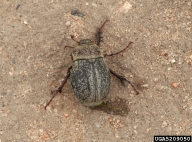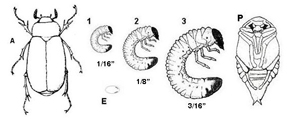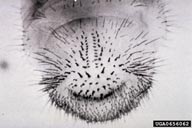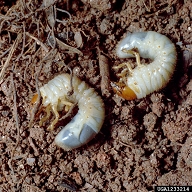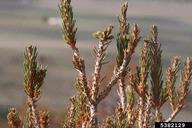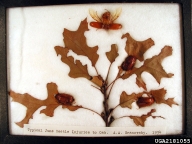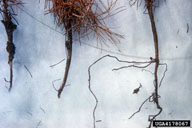May and June beetles
Phyllophaga spp. (Coleoptera: Scarabaeidae)
Orientation to pest
May and June beetles, Phyllophaga spp., are a group of scarab beetles whose larvae feed on the roots of trees and other plants, which can significantly affect survival of seedlings or young trees in plantations. This is a very large group of beetles native to North America. There are more than 250 Phyllophaga species in North America. Most U.S. species occur in the eastern half of the country. In the western part of the country, this group is most numerous in Arizona. Many species occur in Mexico. Here, we present a general view of the biology of the group and mention a few species that are sometimes forestry pests. Adults of several important species emerge in spring and early summer (May, June, especially, hence their name). Adults are large, often brown, beetles that are active in evening or early night and are big enough to be easily noticed (1-3 cm long). Eggs are laid in groups in the soil, about 8-18 cm deep, with each egg enclosed in a ball of dirt.Newly hatched larvae feed on organic matter in the soil but soon switch to feeding on rootlets of tree seedlings, grasses, or other plants. Winter is spent in the soil and larvae move up and down to stay below the frost line. Mature larvae pupate in the soil. One to three years are required to reach maturity in the southern states, 2-3 in mid-latitudes of the United States, and 3-4 years in northern states and Canada. Because of the multi-year life cycle and large number of species, relatively little is known of the population dynamics of particular species.
Damage from Phyllophaga species can occur from either adults or larvae. Adults feed at night on the foliage of many plants including broad-leaved trees, shrubs, and some conifers. Damage from adults is spotty, but when populations are high trees can be heavily defoliated in woodlots or forest edges. Larvae, called white grubs (a name applied to the whole scarab family), feed in the soil on roots of both grasses and woody plants. Damage from Phyllophaga grubs occurs in forest nurseries and plantations the southern and eastern United States. In the western United States, damage from Phyllophaga grubs is less common but is occasionally significant to coniferous seedlings in plantations and nurseries on newly broken sandy land. In the eastern United States, damage to forest nurseries and young plantations can be severe at times. In Michigan and Wisconsin in red pine plantations on sandy soils, as few as 0.75 grubs per cubic foot of soil were found to kill 15-45% of red pine seedlings.
Hosts commonly attacked and distribution of some Phyllophaga species
| Common Species | Comments on Biology (from Drooz 1985) |
|---|---|
| Phyllophaga crenulata (Froclich) | P. crenulata occurs throughout the eastern United States. Adults feed on a wide variety of hardwoods, especially persimmon, hickory, basswood, willow, birch, and buckeye. The larvae are often serious pests in coniferous nurseries in the Lake States. |
| Phyllophaga drakei (Kirby) | P. drakei occurs throughout most of the eastern United States and southern Canada. Adults feed on the leaves of beech, birch, dogwood, maple, basswood, elm, and willow. The larvae are important pests in forest nurseries and plantations in the Lake States and Canada. |
| Phyllophaga forsteri (Burmeister) | P. forsteri occurs throughout the eastern United States. Adults feed on a wide variety of hardwoods such as beech, birch, elm, magnolia, maple, tupelo, walnut, and willow. There are also reports of their feeding on pine. The larvae are often destructive in nurseries in the southern United States. |
| Phyllophaga implicita Horn | P. implicita occurs mostly in the Mississippi and Ohio River Valleys. Adults feed on beech, dogwood, elm, sycamore, tupelo, walnut, willow, basswood, maple, and other plants. The larvae killed millions of seedlings in nurseries in Iowa in the 1930s. |
| Phyllophaga luctuosa (Horn) | P. luctuosa occurs primarily along the Atlantic and Gulf coasts in sandy, oak-pine regions, but also farther north and inland to Tennessee, Oklahoma, and Iowa. Adults feed on persimmon, mulberry, tupelo, walnut, willow, beech, birch, and loblolly and longleaf pines. The larvae are often destructive in nurseries and, probably, plantations. |
| Phyllophaga prununculina (Burmeister) | P. prununculina occurs in the South Atlantic and Gulf Coast States. It is especially common in the Sand Hills of South Carolina. Adults feed on pines, especially loblolly and longleaf, and sometimes oaks and persimmon. The larvae have caused serious losses in pine nurseries and plantations in South Carolina. |
| Phyllophaga prunina (LeConte) (LeConte) | P. prunina occurs throughout the central United States east of the Rocky Mountains. Adults feed on hardwoods, including beech, elm, walnut, basswood, and willow. Feeding on pine has also been observed. Larvae are injurious in nurseries in the Lake states. |
| Phyllophaga rugosa (Melsheimer) | P. rugosa occurs mostly in the northern United States and southern Canada. Adults feed on a wide variety of hardwoods. The larvae are often destructive in coniferous nurseries in the Lake States. |
| Phyllophaga tristis (F.) | P. tristis occurs throughout the eastern United States and in southern Canada. Adults prefer the foliage of oaks but also feed on maple, persimmon, hickory, elm, and willow. Larvae have caused serious losses in nurseries in the Lake States. |
Images of May and June beetles
| Figure 1. Adults of two species of Phyllophaga beetles, showing general body form shared by most species in genus | |||
| Figure 2. Species identification of larval scarabs (white grubs) is largely based on the setal patterns on the tip of the abdomen (the raster) (here a white grub in another genus, theoriental beetle Anomala orientalis [Waterhouse]) | Figure 3. Diagram of life cycle of Phyllophaga implicita | ||
| Figure 4. The C-shape form of a "white grub" and visible legs are typical of Phyllophaga larvae | Figure 5. Damage from adult Phyllophaga species consists of defoliation, usually on hardwoods, but sometimes on conifers. | Figure 6. The most important damage from Phyllophaga species as forest pests is death of seedlings or small trees whose roots are eaten by larvae in the soil, here pine seedings whose roots have been eaten by Phyllophaga larvae | |
Important biological control agents related to this pest species
Parasitoids of May and June beetles include wasps in the genus Tiphia (Tiphiidae), especially Tiphia inornata (Say), as well as several species of tachinid parasitoids such as Microphthalma disjuncta Wiedman. Grubs of Phyllophaga species are also attacked in the soil by various bacteria, fungi and nematodes, some of which have been formulated as biopesticides with varying levels of success in practical use.
Web links for information on May and June beetles
- Management Fact Sheet and Guide | North Dakota State University Extension Service
- Wikipedia Article | Wikipedia, the free encyclopedia
- Generic Guide to New World Scarab Beetles | University of Nebraska State Museum
- Fact Sheet on ForestPests.org | USDA Forest Service, Southern Region
Covers biology and control of white grubs
Articles
- Luginbill, P. and H. R. Painter. 1953. May beetles of the United States and Canada. U.S. Department of Agriculture Technical Bulletin No. 1060, 102 pp.
- Ives, W. G. H., and G. L. Warren. 1965. Sequential sampling for white grubs. The Canadian Entomologist 97: 596-604.
- Ritcher, P. O. 1966. White grubs and their allies. A study of North American scarabaeoid larvae. Oregon State Monographs, Studies in Entomology No. 4, 214 pp.
- Fowler, R. F. and L. F. Wilson. 1971. White grub populations, Phyllophaga spp. in relation to damaged red pine seedlings in Michigan and Wisconsin plantations (Coleoptera: Scarabaeidae). Michigan Entomologist 4: 23-28.
- Liesch, P. J. and R. C. Williamson. 2010. Evaluation of chemical controls and entomopathogenic nematodes for control of Phyllophaga white grubs in a Fraser fir production field. Journal of Economic Entomology 103: 1979-1987.
